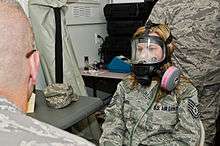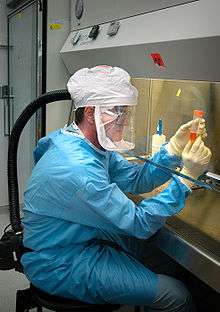Powered air-purifying respirator


- For the full-body lab garment with similar purpose, see Positive pressure personnel suit.
A powered, air-purifying respirator (PAPR) is a type of personal protective equipment used to safeguard workers against contaminated air. PAPRs consist of a respirator in the form of a hood, or full-face mask, which takes ambient air that is contaminated with one or more type of pollutant or pathogen, actively removes (filters) a sufficient proportion of these hazards, and then delivers the clean air to the user's face and/or mouth. PAPRs are sometimes called positive-pressure masks, blower units, or just blowers.
Description
There exist different types of PAPR units for different working environments. Regardless of type, a PAPR consists of (1) some kind of headgear (mask or hood), (2) a powered (motor-driven) fan which forces incoming air through (3) a filter (or multiple filters) for delivery to the user for breathing, and (4) a battery or other power source. The mask may be hard and tight-fitting or flexible and loose-fitting. (The former affords a higher level of protection, but is less comfortable.) The fan, filter, and power-pack may be carried around freely by the user, often secured by a belt around the waist. Alternatively, with certain units, the air is fed to the user via lengthy tubing while the fans and filters are remotely mounted.
Filters
The type of filter incorporated into a PAPR must be appropriate to the contaminants that need to be removed. Some respirators are designed to remove fine particulate matter such as the dust created during various woodworking processes. When used with high-efficency particulate air (HEPA) filters, airborne particles containing pathogens (viruses, bacteria) smaller than 5 microns will be removed. (PAPRs are typically required for lab workers in BSL-3 facilities, and sometimes in BSL-2 as well.) When used in combination with the correct filters, PAPRs are suitable for working with volatile organic compounds such as those used in many spray paints. At the same time filters that are suitable for volatile substances must typically have their filter elements replaced more often than a particulate filter. In addition there is some confusion over terminology. Some literature and users will refer to a particulate filtering unit as a dust mask or filter and then use the term respirator to mean a unit that can handle organic solvents.
Examples
Racal suits
A commercial product known as the Racal suit — or Racal space suit — is a portable personal protective equipment consisting of a plastic suit and a PAPR fitted with HEPA filters that supply filtered air to a positive-pressure hood (also known as racal hood). Racal suits were used by the Aeromedical Isolation Team (AIT) to evacuate patients with highly infectious diseases for treatment.[1][2]
References
- ↑ "The threat to the United States from Emerging Infectious Diseases, Hearing before the Committee on International Relations, House of Representatives". 30 July 1997: 9. Retrieved 15 April 2015.
- ↑ Sidell, Frederick R.; Takafuji, Ernest T.; Franz, David R., D.V.M. (1997). "19". Medical Aspects of Chemical and Biological Warfare. Office of The Surgeon General Department of the Army, United States of America. Retrieved 15 April 2015.